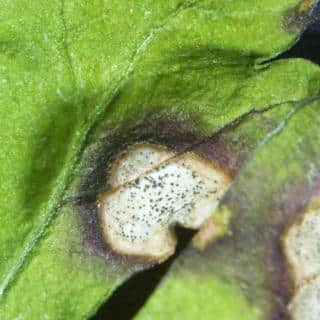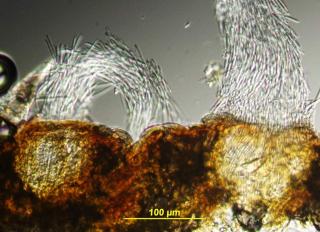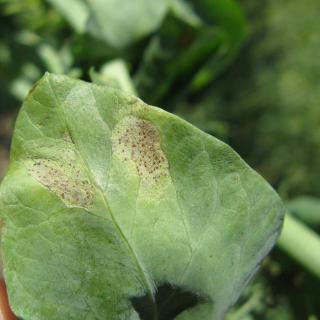

Septoria is a species of fungus that infects vegetables, trees and ornamental plants. In some cases damage is insignificant, in others there’s no hope.
Key Septoria facts
Name – Septoria species
Common names – leaf spot
Type – leaf spot fungus
Season – spring until fall
Target plants – Solanaceae (nightshade family, like tomato & potato) & others (all septoria host plants here)
Infected plant parts – leaves & stems
Main Septoria spot identification
Learn to treat against Septoria and protect plants and vegetables from it.
Septoria is difficult to get rid of, so do your best to prevent it altogether. Understanding the environmental conditions that trigger the disease help prevent it.
Long periods of high temperatures (minimum 60° F / 15°C, more commonly 80°F / 25°C) and high relative humidity both weaken target plants and trigger Septoria growth.
Leaves that stay wet for a long time are its favorite. Water on the leaf serves three purposes for the fungus:
Expect infection when you have the following:
previously infected plants/terrain + high temperatures + high moisture + wet leaves for over 6 hours
Here are 9 important ways you can reduce Septoria infections in your plants.
This helps leaves dry faster when they do get wet, for example in case of rain. It also makes it harder for Septoria to propagate from one plant to the next when they’re further apart.
Here’s a table that shows how certain actions influence air circulation and decrease contamination.
| Action | Air circulation | Spread of septoria |
| raised gardening or container garden |
increases air circulation, moisture drops to between beds |
plants are further up and harder to reach |
| spacing plants | airflow facilitated | neighbors further away |
| staking plants | avoids moisture-collecting canopy, soil surface dries up faster |
neighbors further away, infecting upwards harder than spreading sideways |
| remove lower leaves |
soil surface dries up faster, airflow facilitated |
leaves are further up and harder to reach |
One last point if you’re growing a vegetable patch: orient rows according to dominant winds in your area. Place them so the wind flows through the rows and not across them.
This is one of the virtues of companion planting. Having several crops grow together means pests from one crop land on another – on which they can’t grow and spread!
Various hedge shrubs are vulnerable to Septoria fungal infections, such as cherry laurel for instance.
Additionally, growing different varieties of plants together increases their immunity. It increases diversity of epiphyte micro-organisms that settle on leaves and stems. Having more diversity there means it’s harder for disease-inducing germs to settle in.
Be on the watch for weeds that also host Septoria. These are listed below, in the “Varieties and types of Septoria and the plants they infect” part.
Generally, green manure is a great way to enhance soil health.
Till before sowing or planting to flip the ground over. This will bury spores so they can’t splash up.
Mulch to trap any remaining spores at the beginning of the planting season.
Every fortnight in the growing season, it’s very beneficial to use natural fermented weed sprays on your preferred plants.
Septoria spores will remain active for up to three years on topsoil and plant debris.
Some Septoria strands also contaminate seeds of their host plant. If you’re planting soybean or tomato, ensure that seeds come from disease-free plots of land.
On top of what we mentioned above, one more unexpected tip:
Septoria can spread from one plant to the next through these dew-like drops. Since infection may have started even before the plant shows any symptoms, it’s more prudent not to handle the plants at this time of the day, or whenever they’re wet.
In larger trees and plants, Septoria will wreck more damage on parts of the plant that are more exposed to frost. Indeed, this fungus releases toxins that decrease frost resistance of leaves.

Nonetheless, there is a lot you can do. First, go through all actions related to prevention shared above. After that, follow these steps:
If a plant is more than a half infected, remove it entirely.
If less than half infected, remove all diseased leaves with clean shears.
Dispose of the infected material in either of the following ways:
Don’t compost materials infected with Septoria. Temperatures of over 130 °F (55°C) are needed continuously for over 72 hours to kill spores off. It’s very difficult to obtain this without specific hot-composting practices.
Many kinds of fermented teas can strengthen the plant and make it harder for Septoria to spread. You can use compost tea or make your own fermented tea from weeds.
Spray weekly to contain the infection. Best is to spray early morning to match with guttation. It also ensures leaves dry off faster.
Another option known to repel fungal diseases, including Septoria, is Bordeaux mix.
There are chemical solutions to get rid of fungus, but using them is a double-edged sword.
Note: check labels for when to stop spraying if you intend to eat fruits and vegetables from chemically-sprayed products.
If you can’t practice crop rotation, one option that may be effective is to solarize your soil.
Make note of the following characteristics<!–silent, as described in our page on leaf spot–>:
More rarely, young stems may show signs of infection. Fruits are usually last to be infected.
A laboratory will identify Septoria reliably by looking at the shape and size of the spores and spore-sacs (conidia and pycnidia). A microscope is used for this.
Like other black spot diseases, Septoria is dormant in winter.
When the growing season starts, spores spread to the environment. Most common is during watering or rain, as water is splashed about.

At the end of the season, an infected plant is all withered up, covered in spores. Debris falls to the ground. Septoria spores can resist frost and freezing and in the following spring the cycle starts over.
Each strand of this fungus usually only infects a single host plant species, or a single family. Several, though, are able to contaminate several host plants.
The most famous variety is one almost all gardeners have encountered: Septoria lycopersici, the tomato black spot.
Since conditions that trigger growth are similar to all species, infection may start at the same time on different plants.
Although not necessarily ideal hosts for Septoria, the following weeds make it possible for the fungus to grow and spread:
Disease-resistant varieties and cultivars have yet to be found for most food crops.
For example, only a fraction of all varieties of wheat grown on earth are resistant.
None of the commonly cultivated tomato cultivars are resistant to Septoria.
However, there is hope that resistant hybrids can emerge. Wild tomato, previously grouped under the label “Lycopersicon”, have shown strong resistance to the disease.
Generally, among ornamental plants and vegetables, some varieties are less prone to infection than others.
Basil and thyme (including wild thyme and lemon thyme) are resistant to Septoria.
A few great hedge shrubs have never yet been seen to host Septoria infections:
Especially in the early stages, Septoria resembles the following diseases:

As for most fungus diseases, controlling growing conditions is essential. The first goal should be to avoid appearance and spread of the disease.
There are only few options for biological control of Septoria. These include fermented teas. One major hope is breeding and selection to identify plants that succeed in fighting the disease off.
However, sometimes Septoria can be of use. In one experiment in Hawaii, the fungus was tested as biological control on a locally invasive plant.
This plant, called banana poka, is a type of passion flower. It had overrun entire mountains.
Contaminating the plant with Septoria passiflorae succeeded in eliminating 95% of the invasion on some test sites!
Similar experiments with Septoria helped control spread of another invasive flower shrub in Hawaii, Lantana camara.
As shown in our list of plants vulnerable to Septoria, there are a great many species of this fungus. Currently, they’re classified together mostly because of similarities in how they appear and spread.
Each sub-species or variety is set apart from its peers simply because it infects different host plants.
More recently, DNA analysis of various strands is attempting to classify these fungus according to genetic closeness. This has already revealed that some species thought to be Septoria are actually closer to other types of fungus.
Furthermore, in laboratory conditions, strands thought to be specific to a certain plant were able to infect different plants. There is still much to learn about this surprising fungus!
Read also:
After a serious infection, it may be wisest to not plant any target plants in the following year. Ask a neighbor if you can grow tomatoes in his or her garden, or set up a community garden nearby instead!